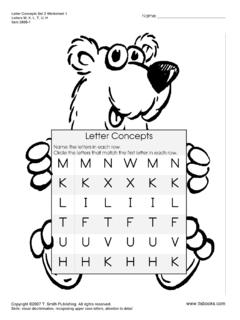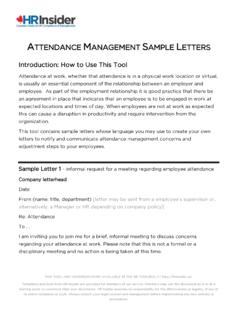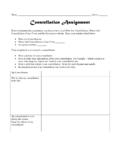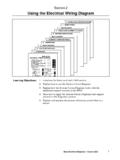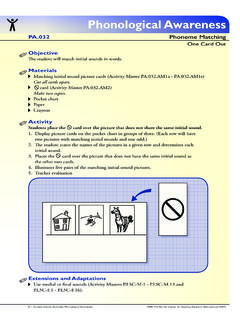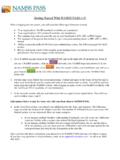Transcription of Facets Tutorial 1 - Winsteps
1 1 # Many- facet Rasch Measurement : Facets Tutorial Mike Linacre - 1/2012 1. Tutorial 1. Software operation and basic concepts Welcome! Facets software operation Data entry methods, including Excel Facets , elements, persons, items, raters Simple dichotomous and polytomous analyses Measurement rulers This Tutorial includes a quick run-through of the operation of the computer program, Facets . 2. [deliberately blank] 3. 4. 5. 6. 7. 8. 9. 10. 11. 12. 13. A. Running the Facets Program 14. You can launch Facets at any time by double-clicking the short-cut on your desktop. You can also drag Facets specification files onto the Facets short-cut to launch them.
2 15. Launch Facets . The main Facets window displays. The Facets program performs Many- facet Rasch Measurement , MFRM. Notice the menu bar across the top of your screen. Let s look at the Help function. Position your mouse to Help, and then left-click on it. 2 16. Now click on Help F1 to activate the Help screen. You can also press your F1 at most times to activate Help. 17. Facets Help screen displays. This contains the same information as the Facets manual, , which is in your Facets folder. Left-click on the next to Special Topics to expand the topic list. 18. Then left-click on Glossary to display a glossary of Rasch technical words.
3 You may find this useful if you don t understand the meaning of a word in this Tutorial . Please tell me if you need to know the meaning of a word not in this Glossary. Click on A to increase the size of the text. Click on A to decrease its size. You can leave this Help window open if you want to. It will close automatically when this run of Facets ends. 19. On your Windows task bar (usually the bottom of your screen), click on Facets 20. The Facets -analysis window displays. The Facets program performs Many- facet Rasch Measurement , MFRM. Notice again the menu bar across the top of your screen. We want to select a file to analyze, so click on Files 21.
4 Click on Specification File Name? Many researchers use both Facets and Winsteps , so to avoid confusion, the analysis file is called the specification file for Facets and the control file for Winsteps . They have the same function, but many differences. 3 22. The examples folder displays. Yours may look different if you have chosen a different Windows style. These are the example specification and data files. Click on or Essays Then click on Open (or double-click on or Essays) 23. You may not see the .txt suffix with your file names. That is OK, but if you want to display the suffixes, follow the procedure in Appendix 1 at the end of this document.
5 24. The Specification file name, C:\ Facets \examples\ is now shown in the Facets window and the Extra specifications? box displays. This box is useful for giving last-minute instructions to Facets , but we won t do that now, so Click on OK 25. The specifications (instructions to Facets ) in the file are processed to make sure that they specify a viable analysis. When there are many specifications, this can take considerable time, so a progress bar: >..< is shown on the Facets Analysis window. Then you are prompted for the Report Output file name. One is suggested . We will accept it, so Click on Open 26. The analysis runs. On my computer it takes 34 seconds for this small dataset when run without interruption.
6 The analysis output report is written to our output file . 4 27. B. The Output File of Tables = Output Tables File 28. The output file, , is displayed in an Editor window by NotePad. Most Facets input and output files and windows are text files. They are usually displayed and edited with NotePad. NotePad needs to display with a fixed-space font, such as Courier New, and a small font-size so that this displays neatly. Appendix 2 explains how to do this. If you want Facets to use a different text-editor, such as WordPad or TextPad, see Appendix 3 29. Let s scroll down this output file to see what Facets tells us about The output file is divided into many output Tables and Sub-Tables.
7 The first one is Table 1. Table 1 summarizes the Facets specifications. This is helpful if want to save your analysis output and then remind yourself later of what you did. It is also useful when the analysis didn t come out how you expected. Look at Table 1 - This answers the question Are the specifications what you intended them to be? 30. There are two lines in Table 1 that are crucial to a successful analysis. Green box: Facets = reports how many Facets there are in your analysis, and Red box: Labels = reports how many elements have been defined in each facet . If these numbers are incorrect, then the analysis is almost sure to be wrong.
8 31. What are Facets ? Most statistical analyses have rectangular datasets. The rows are cases, subjects, persons, .. The columns are items, probes, tasks or other variables. The Facets program can analyze this type of data, but it can do much more. In our terminology, a typical rectangular dataset is a two- facet analysis. The rows are one facet . We label (or name) that facet by what it means to us, so we might label the rows, facet 1. Students or facet 1. Patients . The columns are another facet , so we might call them facet 2. Items . In a rectangular dataset, we imagine that (something about the row) + (something about the column) (the data value, observation, response at the intersection of the row and the column) Some Facets : "Tasks" and "prompts" provide the context, , when the task is an essay: "write an essay".
9 "Items" are the immediate probes to which the raters respond, , item 3 is "grammar". Persons , Subjects , Cases , Objects of measurement are what is being rated. "Rating scale" is not a facet . It is the definition of the response structure, , a performance rating scale could be "0=deficient, 1=acceptable, 2=good, 3=excellent", but sometimes items are called scales . 5 32. Three Facets : But the situation can become more complicated. What if this is a piano competition? each candidate plays 3 piano sonatas and each of those 3 performances is rated by several judges? Then (something about the candidate) + (something about the piano sonata) + (something about the judge) (the data) This is a 3- facet analysis: facet 1.
10 Candidates + facet 2. Sonatas + facet 3. Judges. There is nothing special about the numbering of the Facets . So we could specify: facet 1. Judges + facet 2. Candidates + facet 3. Sonatas. We number the Facets in the way that is best for our own thoughts, and best for us to tell other people what we have discovered. facet 1 is usually the facet that is most important to us. 33. The analysis has 4 Facets . This is what we imagine: examinees + essays + readers + sessions data So what is going on? This is an essay examination. each examinee writes several essays. The essays are rated by the readers. There are so many essays that it takes several reading sessions to read all the essays.
